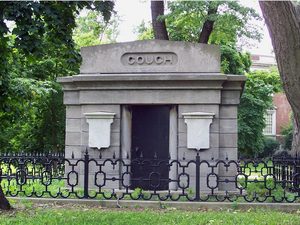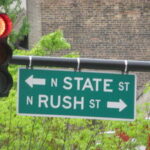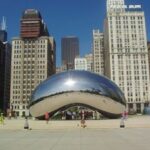You wouldn’t know it today. Home to DePaul University, Lincoln Park Zoo, and numerous homes and businesses, Chicago’s Lincoln Park is a haven for college students and young professionals. It has become one of the most popular neighborhoods in the city due to the proximity of Lake Michigan and easily accessible public transportation.
In the early nineteenth century, however, North Avenue marked the boundary of Chicago. The relatively remote, cheap land to the north made the area an ideal location for the less desirable necessities of the city. In fact, Lincoln Park first existed as neither a park nor a desirable neighborhood. The land at Clark Street and North Avenue was initially earmarked for the Chicago City Cemetery.
Early History
Chicago passed an ordinance in 1842 to use land acquired from the state to establish a new public cemetery, as expansion and overcrowding had encroached upon the original graveyards at Chicago Avenue to the north and Twelfth Street to the south. The first interments at City Cemetery commenced in 1843. In the same year, officials passed another ordinance forbidding burials in older graveyards. Just under an acre of the land in 1846 was set aside for the Jewish Cemetery. Information from the earliest history of the cemetery is sketchy, however, as detailed written ownership records were not required until 1851.
Over the years, the cemetery grew as lots were sold and remains from the old Chicago Avenue cemetery were reinterred within it. In 1850, the city purchased 12 acres of adjacent land that it had originally sold to the Milliman family prior to establishing the cemetery in order to expand its grounds. Even by then, Chicago’s ever-growing population was outpacing the city’s ability to make room for its dead.
Worsening Conditions
As early as 1855, articles in the Chicago Daily Democrat began suggesting that City Cemetery was an ill-chosen site. It seems that lakefront property was prime real estate even then, as the boundaries of Chicago kept creeping northward. A petition soon followed, asking city officials to convert the cemetery into a public park. Some citizens even offered to exchange land with the city if the council would move the cemetery out of the city limits (which had long since encompassed the grounds). As for proponents of the cemetery, a number of petitions pleaded for the city to improve upon its poor conditions.
By late 1859, the last lots of the Chicago City Cemetery had been sold. Rosehill Cemetery had opened in May, and by the next summer, it had been joined by Graceland and Calvary cemeteries. While some disinterments had already begun at that stage, thousands of burials continued in City Cemetery through 1866.
The Death Knells
In 1865, the Illinois Supreme Court ruled that the city had illegally acquired the 12-acre Milliman Tract back in 1850, ending more than two years of court battles. The city was faced with paying $75,000 or returning the property to the Milliman heirs. Officials decided that removing the dead and giving back the land was the cheaper option. The city exhumed 1,635 bodies from the tract, relocating them to other cemeteries.
In 1869, the Lincoln Park Act turned over control of the property from the Board of Public Works to the Lincoln Park Commissioners. It was assumed this would hasten the reclamation of the remaining cemetery grounds, as the legislation detailed how the commissioners were to incorporate the burial grounds into park expansion. Although some families were moving their departed loved ones’ remains from the rest of City Cemetery, there was enough resistance from lot holders–and a lack of public funding–to deter a wholesale removal of all graves. Despite the legal setbacks, despite the loss of some grounds to the park, it seemed that the cemetery would persist. Then came the disaster of the century.
The Great Fire of 1871 burned all the way north to Fullerton Avenue. City Cemetery was in its path, first trampled by the hundreds of refugees fleeing north, then ravaged by the flames. Many grave markers were destroyed, their sites left unmarked and soon forgotten, lost amidst the ruin. In the aftermath of the blaze, the cemetery was a victim of the cleanup. A massive disinterment effort began in 1872; in 1874, the Lincoln Park Commission had condemned the remaining 712 burial lots still containing graves. The last acknowledged removals in this process occurred in 1877. Over the years the land was eventually reclaimed and rebuilt, although the occasional erstwhile reminder still makes its presence known.
Lincoln Park: The Present
In 1892, The Chicago Daily Tribune reported “Of the stones and memorials which once marked the resting places of the countless thousands buried in what is now Lincoln Park, the tomb of the Couch family alone remains.” Erected in 1858 to house the remains of Ira Couch, the vault has outlasted time, nature, and the best efforts of city officials for more than a century to stay right where it is. It remains unclear to this day why the mausoleum was never moved, or even who is actually buried inside it. But there it stands, in plain view near North Avenue and Lake Shore Drive. Efforts in the 1990s have restored the tomb after countless years of neglect.
To the north, near Lincoln Park Zoo, a plaque on a rough-hewn boulder commemorates the resting place of David Kennison. He died in 1852, but the memorial claims that he lived to the age of 115 and was the last survivor of the Boston Tea Party. The boulder and plaque were originally placed in the park facing south in 1903. In 1935, the boulder was moved approximately 100 feet to the north. Meanwhile, the Chicago Historical Society records his grave location as “interred in Lincoln Park about 320 feet n.w. from the Couch tomb, and about 30 feet east of the east line of North Clark Street,” which would place his grave nearly two blocks south of the boulder. His exact resting place remains unknown.
There are no official estimates as to how many unexhumed graves remained when the City Cemetery gave way entirely to Lincoln Park. Well into the twentieth century, though, excavations in the area would occasionally turn up bones. During construction of the Chicago Historical Society’s new parking garage in 1998, workers uncovered 81 partial skeletons and an iron coffin containing a remarkably well-preserved corpse. Given the gaps in records and the passage of time, there could be hundreds, perhaps thousands, remains left scattered throughout the neighborhood.
The Chicago City Cemetery may be long gone, but its legacy endures.
Sources
Hidden Truths: The Chicago City Cemetery and Lincoln Park, Encyclopedia of Chicago, Graveyards.com, The Chicago Tribune, The Chicago Historical Society







